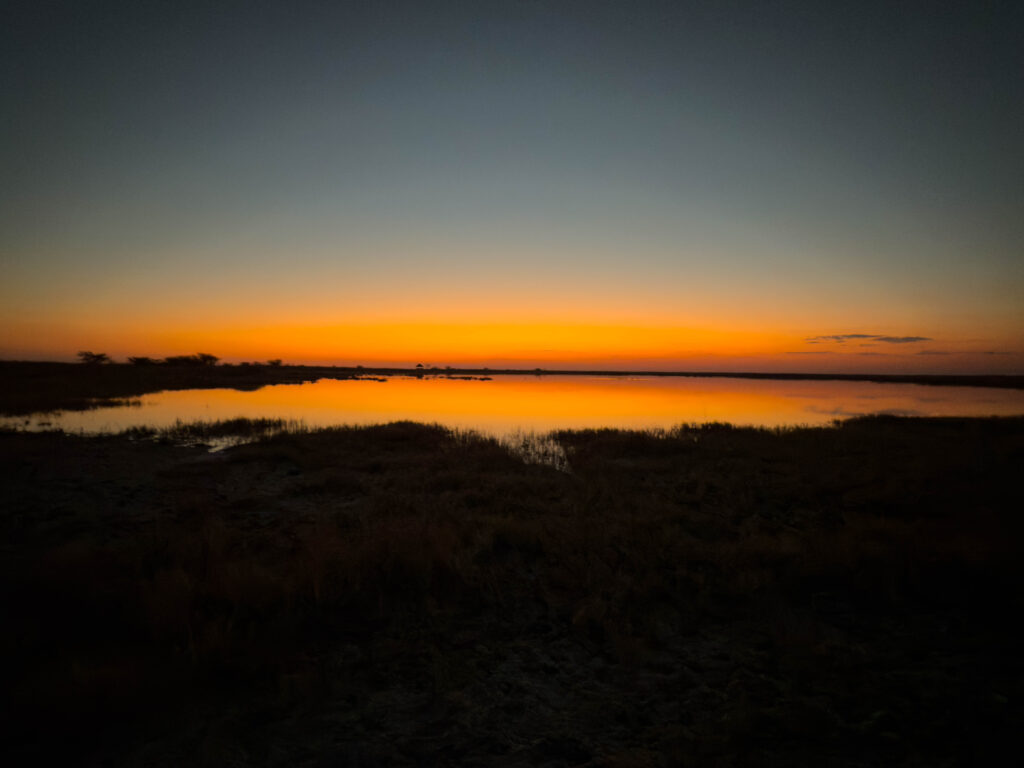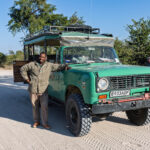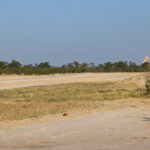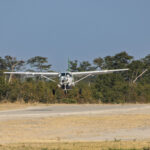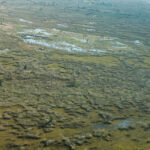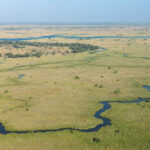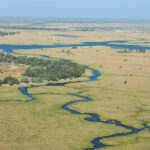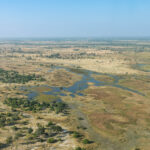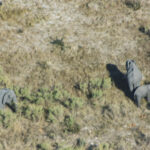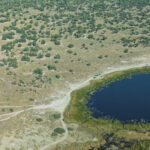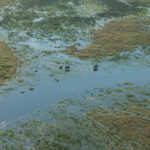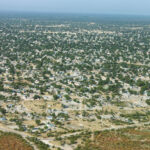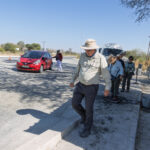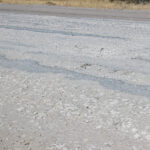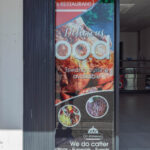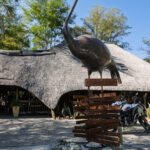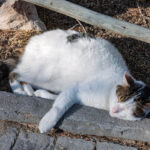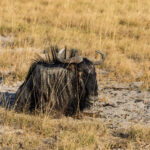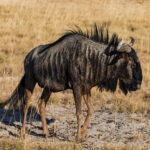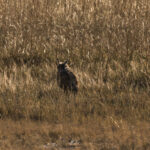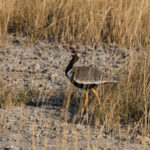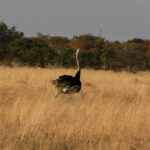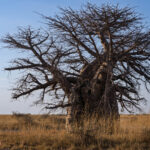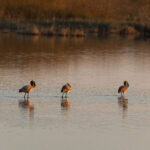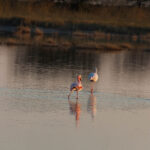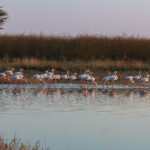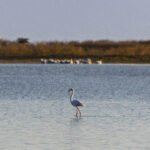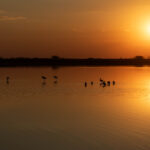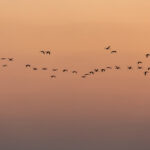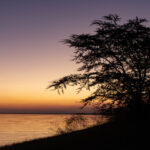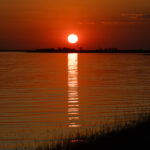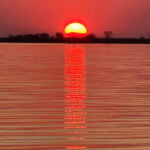Sunday, 8 June 2025
Another comfortable night in our tent before a 6.30am wake up call. We re-packed our small bags – we were only allowed to bring a carry-on sized bag each to our bush camp – before venturing to the mess tent for breakfast. At breakfast Solomon handed out the Happy Sheets for us to give feedback on our bush camping experience. It was five points all round from us after a very enjoyable two days ‘roughing it’.
Seriously, once I knew that I would not have to go outside to pee in the middle of the night … since I always need to pee in the middle of the night … I was happy. As long as there was some canvas between me and any carnivorous wildlife I felt confident I would manage. In the end, it wasn’t as spooky as our last camping trip in the Victorian High Country when we had a dingo howling during the night and I had to get out of the swag and venture around the end of the MU-X to use the Porta Potti!!
While we had breakfast, the camp crew were already starting to pack up the camp. All we had to do was carry our small bags over to the truck to be loaded and leave everything else to the team. We were loaded and ready to go just after 7.30am so headed off on the short drive to the airstrip hopeful that we might yet see some more wildlife. All we saw though was common impala and hornbills … which are also proving common!
Arriving at the airport, Solomon drove part way along the runway checking for any wildlife or obstructions. There was a shovel in the back of the truck to shovel elephant poo off the runway if necessary, but it was all clear. Soon, Solomon and Wian were saying that they could hear the light plane coming. Ahem, younger ears and better hearing than the rest of us! Before long though, we could see the plane, which did a flyover, checking the runway and watching for any signal from Solomon that there was a problem. The pilot touched down lightly and taxied to the end of the runway.
After last minute pre-flight bush toilet, we said our farewells to Solomon and then we were loaded into the Cessna Grand Caravan EX, an eleven-seat utility aircraft operated by Mack Air. Our pilot, Moses, welcomed us aboard, gave us a briefing on what to expect during the flight and then we were off on our aerial adventure. After several circuits over the Okavango Delta, to give us a bird’s eye view of the area we had been exploring on the ground for the last two days, Moses pointed the nose of the aircraft towards Maun.
Flying at just 500 feet above the ground we enjoyed fantastic views of the expanded waterways, white clay pans and palm-lined lagoons. We had our eyes peeled for hippos in the channels, and elephants and buffalo huddling in the shade of the trees. It was absolutely incredible seeing elephants, giraffes, hippos and antelopes from the air. Very difficult to photograph the wildlife, even with a window seat, but WOW!
Shortly before 10.00am Moses landed us with a featherlight touch at Maun International Airport. It may be an international airport by name but it is only a tiny, tiny airport in reality and it’s main traffic is scenic flights over the delta. A Mack Air courtesy bus transferred us to the terminal building and a Maun Lodge courtesy bus drove us between the airport and the hotel, where we were reunited with the trusty ISUZU truck and the rest of our luggage.
We made a short drive to the servo where Wian filled up with diesel and the rest of us purchased snacks for the journey. Well, Bernie had a Magnum for morning tea AND bought snacks for the road. With fuel and food sorted we set out on the A3 heading eastwards towards Nata.
Around 11.00am we reached the Veterinary Line where we all had to disembark to walk though a tray filled with chemicals to disinfect our footwear in case of possible contamination with foot and mouth disease. We walked through the tray and then alongside the vehicular trough that the truck had to drive through, trying to stamp the excess chemical off the soles of our shoes and dry them out a bit before re-boarding.
Despite being outside a designated park now, there was some wildlife about. We spied an elephant that looked like it had recently passed through water as it had a water mark along its flank. We also saw a lone zebra and then a group of five elephants. Oh, no, we were pulled up by the police for speeding. Allegedly doing 90kph in an 80kph zone. Hmmn, everyone was certain that we had not passed an 80kph sign but Wian had to cop the fine anyway – 1,600 Pula, about AUS$180.00. Oops! Of course cynics would say that you are fair game with the police when your vehicle is wearing registration plates from another jurisdiction!!?
The usual roadside animals prevailed now, cows, goats and donkeys, although we did see a lone ostrich which was a bit more interesting. We stopped in Gweta for more snacks, even though we had shared a packet of chips on the road. With not much to choose from I ended up having Oreos for lunch. The servo, with combined convenience store, that we stopped at seemed very new and was lovely and clean … including the loos but, of course, we were all scratching around again trying to find small denominations of Pula to pay with.
Wian announced that we had arrived in the area where we could expect to see baobab trees and soon enough we spied the first of these strange, upside-down-looking trees, seemingly spreading its roots over its trunk. Debbie told us a story the other day that when God originally created the baobab tree it was every vain and believed itself to be the most beautiful of all the trees. God punished the baobab for its vanity by turning it upside down. I hadn’t heard that one before.
The landscape changed again and there were plains of golden grass beside the road with a large mixed herd of cows and horses grazing on what they describe in northern Queensland as ‘standing hay’. At about 40Ks out of Nata the ‘good’ bitumen ran out and it was a very rough ride alternating between the road and the (very) hard shoulder as Wian attempted to drive the smoother bits and avoid the biggest potholes. We crossed the Nata River and rolled into the Nata Lodge about 2.30pm with our fillings still intact, ha, ha.
This fascinating region situated in the dry savanna of north-eastern Botswana, is known as the Makgadikgadi Pan. It is made up of a series of salt pans all crossing over each other in the barren wilderness. Typically, during the dry season (March to September) the pans are nothing more than empty, cracked mud, however, in the wet season (November to March) it comes alive as a haven for the wildlife that flock to the watering holes.
After settling into our rooms (briefly) we were off out again with our driver, PK, to explore our incredible surroundings on a guided nature drive in an open safari vehicle, discovering the Sua Pan and Nata Sanctuary, located in the depression of what was once Lake Makgadikgadi. At that time, it was part of a vast and exceptionally fertile area filled with lakes, rivers and marshes that were surrounded by grasslands and forests. It is believed that modern Homo sapiens evolved in this part of Africa between 100,000 and 300,000 thousand years ago, before spreading across the globe.
We left the road and drove out onto the salt pan with the salt crust crunching beneath the wheels of the vehicle. Out in the pan, our first sighting was of a blue wildebeest and then we were lucky to be treated to a rare, if fleeting, glimpse of an aardwolf as it ran across the road and disappeared into the long grasses. Next was a white-quilled bustard, which PK told us is also known as the mother-in-law bird or the helicopter bird, because of its habit of hovering before plunging to the ground.
We caught a glimpse of an ostrich sitting in the grasses but, when we drove closer, it jumped up and ran off. PK checked to see if it had been sitting on a nest, but he found no nest where the bird had been resting. He told us about how ostriches nest communally. The alpha birds will build a nest and lay eggs, then other hens will seek permission to lay their eggs in the nest. The alpha birds agree to this, although always keep their eggs in the centre of the clutch. The alpha birds might incubate up to 30 eggs on behalf of the flock!!
Next PK drove us to look at a seven to eight-hundred-year-old Adansonia digitata or African baobab tree. So ugly! He explained that baobabs originated in Madagascar where there are eight species. It is believed that seeds floated from Madagascar to other countries where baobab trees are found, including Australia where baobabs (Adansonia gregorii) are found in Western Australia and the Northern Territory.
We drove to an area filled with water, where we found flamingoes with their chicks. After plentiful rain this year, flamingoes are breeding here, after arriving from the coast of Namibia about a month ago. Most of the birds that we saw were the greater flamingo which tend to be more white, with one, lone, pink lesser flamingo amongst them. The immature greater flamingos were still grey at the moment. We also saw a flock of great white pelicans … in the distance.
As sunset approached, we pulled up beside the huge expanse of water currently filling the Sua Pan. Another day, another sundowner, with the drinks and nibbles coming out of the coolers for us to enjoy while the sun dipped below the horizon. Tonight’s sunset was a spectacularly red one.
After the sunset, it was time to return to the lodge in the dark and, gosh, had it turned cold since the sun dipped below the horizon. Add to that the wind chill factor of driving along in an open-sided vehicle and it was FREEZING! We were very pleased to arrive back at the lodge for some dinner, which tonight was a set menu format.
After dinner we returned to our room, where Bernie decided to brave the outdoor shower. I opted to bathe in the freestanding bath inside the room. We have had several luxurious, freestanding baths in our rooms but haven’t found (or made) the time to enjoy them. Tonight, I thought, I shall treat myself to a soak. Blissful.
Enjoying some reliable internet tonight, we managed to post some of our adventures on our website. Yay!
Steps: 8,830 (6.07kms)

